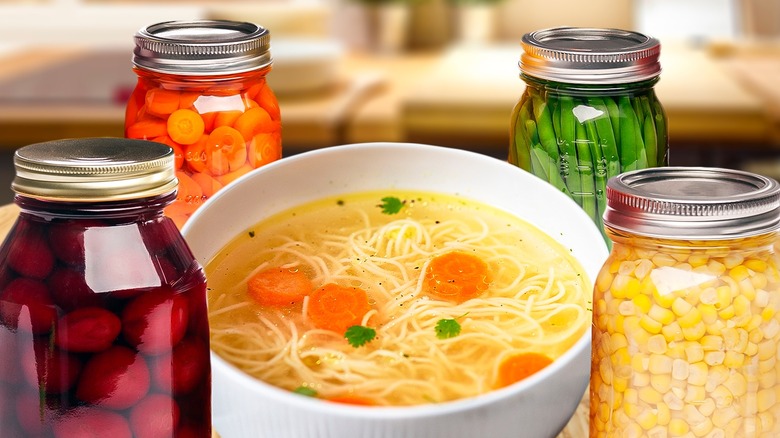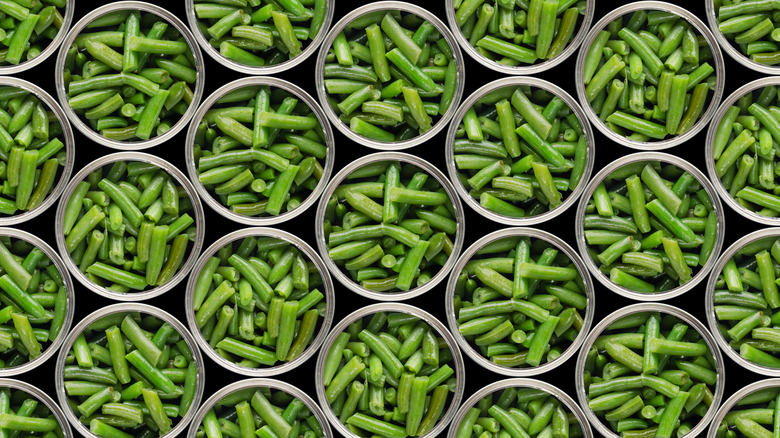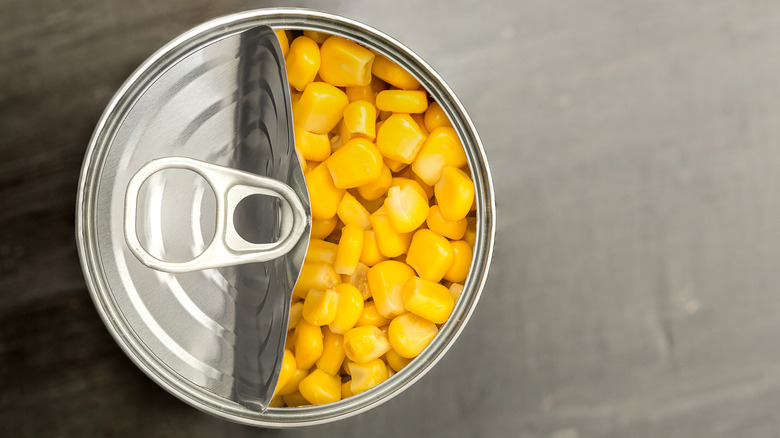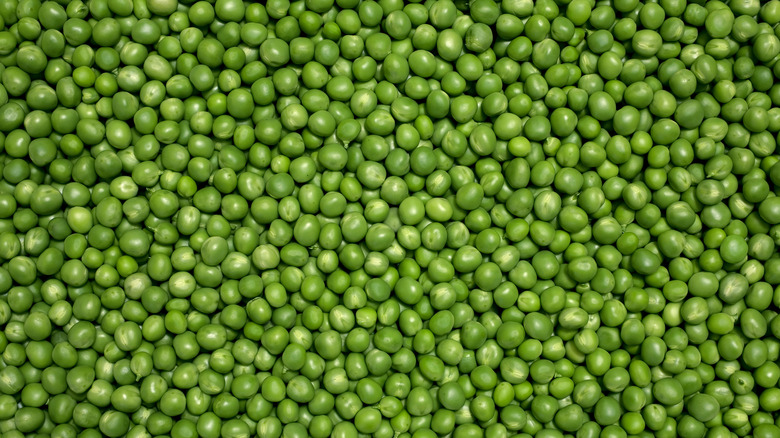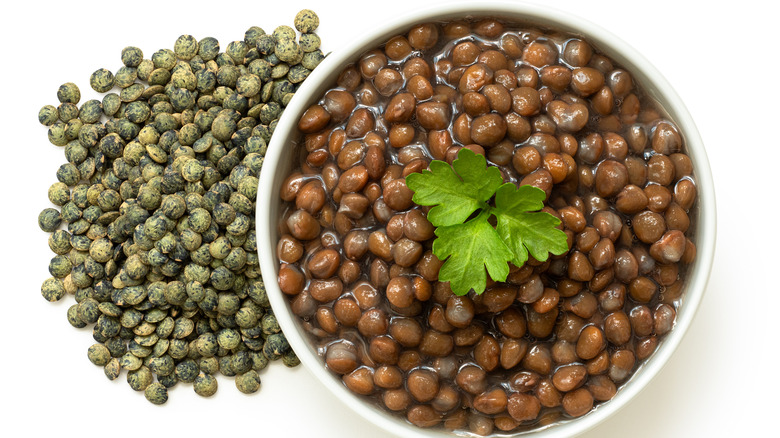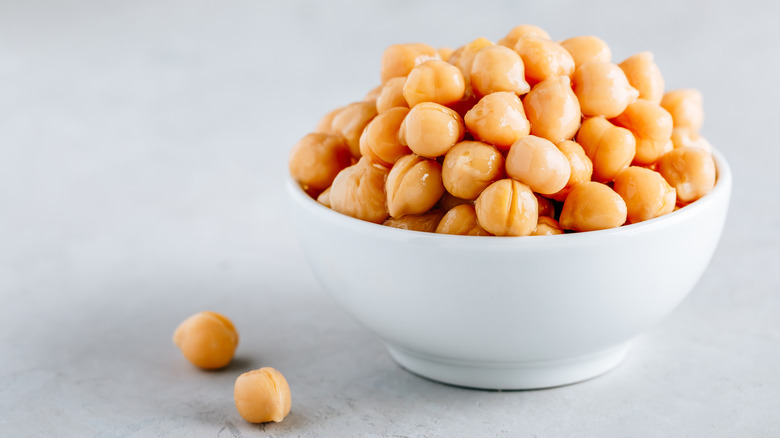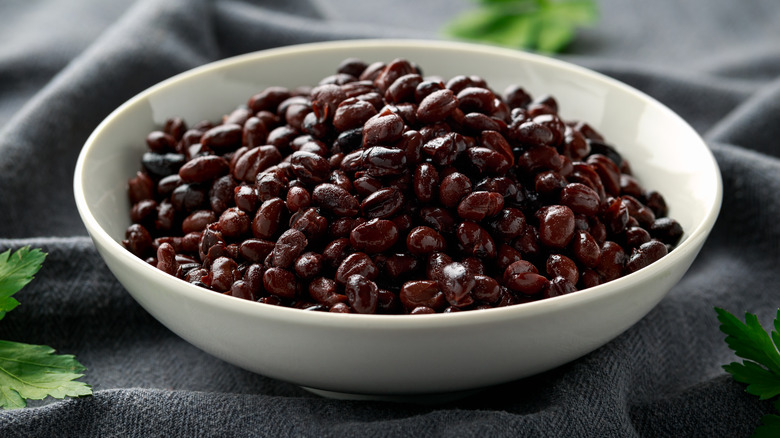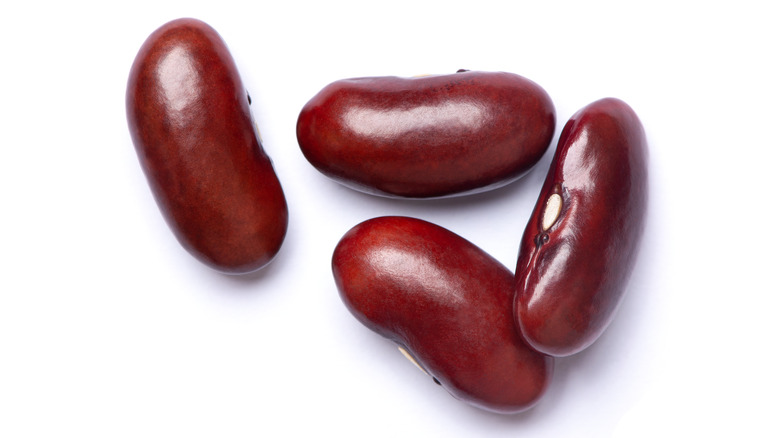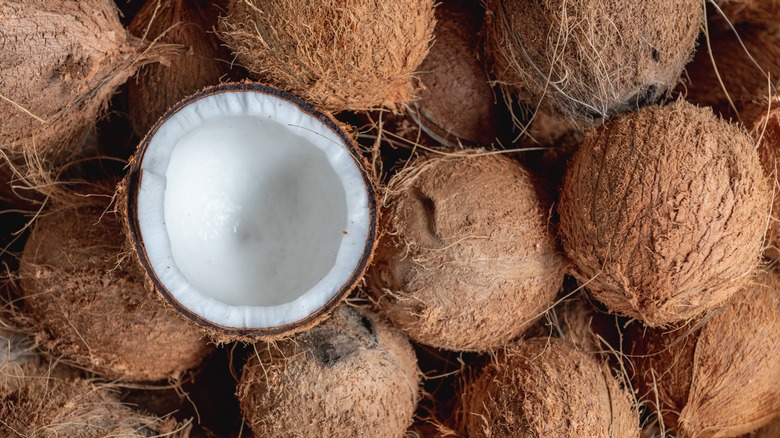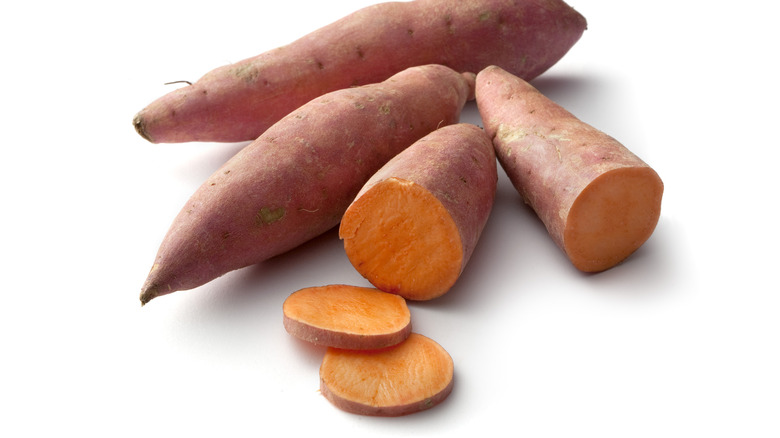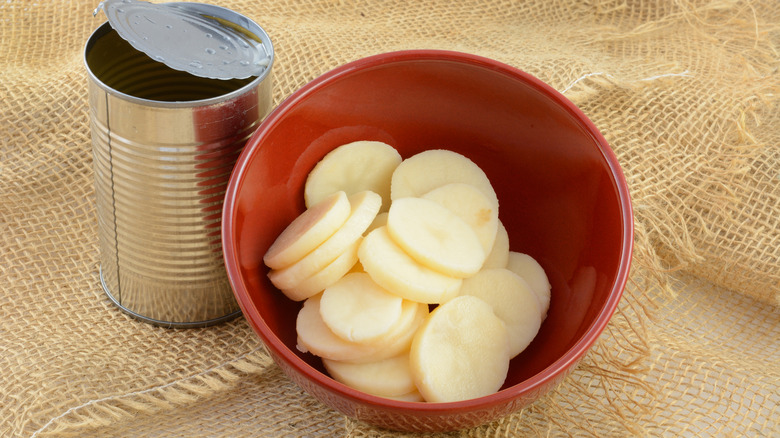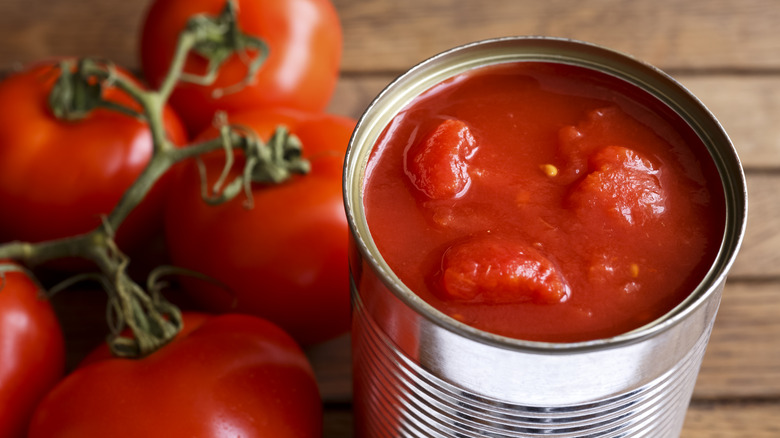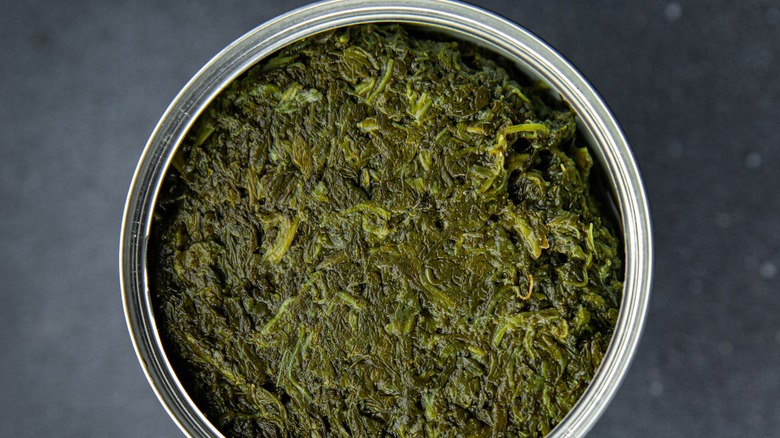The 13 Best Canned Ingredients For Bulking Up Homemade Soup
There is something quite reassuring about having a pot of soup simmering away on the stove or in the Instant Pot. This proves especially true on days filled with dreary weather when your household faces yet another round of colds or when the refrigerator looks more empty than full.
One part comfort food, one part optimism, soups are often made from the simplest ingredients, plus the magical ingredient of time (and, sometimes, thyme). A mainstay in just about every culture, soups help see communities through the toughest of days, which means it's wise to keep a few base ingredients around, because we never know when we'll need soup most.
Pantry goods, from pasta to canned vegetables, are an excellent resource for feeding a crowd in the form of a cauldron of soup or stew. Here are just a smattering of suggestions of canned items you want at your fingertips. With these in your pantry, you can easily make and extend your next bowl of chicken noodle, beef and vegetable, laksa, or whatever soup you fancy, just a little bit further.
Green beans
Nothing beats the sweet crunch of a freshly picked green bean but canned green beans work as a fantastic alternative, especially when green beans are out of season or meant directly for soups. A good source of vitamins C, K, and A; green beans also provide lots of potassium, folic acid, and fiber. Highly adaptable vegetables, with a mild taste and soft but firm texture, they enhance many soups, including vegetable and beef, tomato, and minestrone. Just remember to rinse the beans before using them to avoid over-salting your dish.
Canned green beans can also make a flavorful addition to the family meal on their own, especially if simmered briefly in the dregs of broth or stock of whatever soup you've got going. All the more reason to keep a few cans of green beans in your cupboard and to consider using every sip of soup left in the bottom of the pot. Don't waste a drop!
Corn
Always store a can or two of corn in the cupboard. These sweet, golden jewels provide an excellent textural addition to everything from soups to soufflés. More than merely delicious and satisfying, corn bulks up a soup, stew, or chili with a complex carbohydrate that both helps the dish stretch further and staves off hunger for longer.
There are numerous ways to use a tin of corn kernels in your soup. Stir a tin into your next beef and vegetable soup, sprinkle into a pot of black beans, or toss the contents into a tomato base of chicken and tortilla. You could also lean into corn's earthy flavors and whip up a rich and chunky corn chowder or blend it into a smooth and creamy corn soup. No matter how you choose to utilize it, adding a can of corn into the mix practically guarantees tummy-filling, smile-inducing satisfaction.
Peas
Of all of the ingredients on this list, the longer peas cook, the more likely they will turn out the softest or dissolve into mush. It's not bad, just something to note as you consider when to add which ingredient to your pot of homemade soup.
While the frozen kind certainly gets the brightest spotlight, canned peas are equally delicious and comfortingly gentle on the palate. Do notice what kind of peas you purchase, as marrowfat peas, the kind used to make Britain's famous mushy peas, are more mature and will have a much softer and grainier texture than the younger garden peas variety.
Due to their softer texture, consider adding a can of peas towards the end of the soup's cooking process to help them retain their satisfying shape. Add to the pot at the very end for vegetable soup, split pea soup for texture and bulk, or into other creamy soups like cauliflower cheese, potato, or otherwise. A few cans of peas, a little bit of brown sugar alongside some stock, and a few other essential ingredients could also serve as a fantastic soup on its own.
Lentils
Lentils, one of the oldest, most versatile, and most widely consumed legumes on the planet, come packed with nutrition, including fiber, protein, vitamin B, and folate. They also present an easy and affordable way to add nutrition and long-lasting energy to any meal. While dried lentils are always great to have on hand, canned lentils eliminate the need for soaking. Ensure you rinse the canned lentils under the faucet to remove any excess salt before pouring them into the pot.
Gather a few cans of lentils and carrots for a quick-and-filling, flavorful lentil soup. Keep the soup chunky or blend with a tin of tomato or coconut milk (or both!) for a creamy, smooth soup that will fill you with energy and good nutritional support and keep you fueled and satisfied until your next meal. Lastly, a can of drained and rinsed lentils is a welcome addition to just about any pot of vegetable, beef, chicken, minestrone, or other soup. Feel free to step outside the box and experiment with whatever soup is on the menu.
Chickpeas
It shouldn't be news-breaking information that a well-placed can of chickpeas can transform a meal, stretching dishes to feed a few extra people and delivering substance, flavor, and nutritional heft. Add a tin of strained and rinsed chickpeas into a pot of vegetable soup, miso-infused orzo soup, minestrone, or Moroccan chickpea stew, and save the liquid for vegan-friendly baking.
What's more, chickpeas don't have to just sit inside a bowl of soup. They can also float on top. Roasted chickpeas take on a totally different texture and can make an excellent fiber and protein-dense alternative to crunchy croutons. Add drained, rinsed, and dried canned chickpeas to a roasting tin, massage with oil, sprinkle with flaky salt and whatever seasoning you like, and roast until golden and crispy. Then, serve a bowl of creamy soup, like roasted cauliflower, alongside a bowl of roasted and seasoned canned chickpeas. Let guests help themselves to a satisfying textural garnish that will keep everyone's hunger satiated for hours.
Black beans
Indigenous to Central and South America where they were first cultivated over 7000 years ago, black beans remain a staple in many diets across a wide number of cultures. They have stood the test of time and are a powerhouse of nutrition and fuel, loaded into a tiny (some might say adorable) little body. There's nothing quite as wholesome and filling as a pot of black bean soup, so having a can or two of black beans in your pantry is a good idea. Thanks to their high amount of fiber, when it comes to rib-sticking, sturdy dishes, black beans are as versatile and practical as they are delicious. They're a welcome addition to any pot simmering away on the stove.
They are, of course, the star ingredient in a black bean soup, but that's not all they can do. Black beans are welcome in a meat-based or vegetarian chili. They bring heft and flavor to a pot of tortilla soup. They're also excellent for texture, protein, and fiber in a creamy tomato. Want to stretch your batch of vegetable soup a bit further? Black beans are here to help.
Kidney beans
Perhaps one of this list's more underrated and overlooked pulses, and often just thought of for chili or three-bean salad, humble canned kidney beans deserve a little more credit and praise than they often receive. Mild, creamy, and earthy kidney beans are a great, inexpensive source of plant-based protein and can be added to chili, soups, and stews, and blended into dips. They're also high in fiber, folate, and various vitamins and minerals, from copper to potassium. Further, kidney beans rank low on the glycemic index, meaning they won't spike blood sugars despite their high density of carbohydrates.
Adding a can of drained and rinsed kidney beans to your next pot of minestrone or pasta e fagioli is a great way to extend the life and reach of the dish. Dishes like these also taste even better the next day, elevating leftovers into something to look forward to.
Coconut milk
Want to add bulk to your homemade soup in a slightly different way? A can of rich and creamy coconut milk might be a good option. High in fat and calorie-dense, coconut milk increases soup bulk by creating a filling broth. Coconut milk also contains vitamin C, folate, iron, magnesium, and other minerals, making it a healthy addition.
Coconut milk is used widely across various cuisines and cultures, including those of Southeast Asia, South Asia, South America, and the Caribbean. Plenty of soups, stews, curries, and sauces benefit from coconut milk and the satisfying richness it imbues. Having a few tins of coconut milk in your pantry always pays off, whether you're cooking a Malaysian laksa or a Thai-inspired coconut soup. We consider it one of our favorite go-to ingredients.
Carrots
Canned carrots rank as one of the least-valued canned vegetable varieties. Though missing that bite and crunch associated with the fresh version, canned carrots offer several benefits and shouldn't be dismissed. Keeping a can or two hanging around is a great idea to bolster the nutritional value of whatever soup you've got on the way.
Cooked canned carrots are an excellent source of beta-carotene, necessary for a whole host of things from eyesight to skin health to memory. They can be a welcome complement to a pot of vegetable soup and add extra carrot flavor when blended into a batch of creamy carrot and coriander soup. Likewise, canned carrots can be blended into a coconut milk-based stock or broth for extra sweetness and added nutrition. Carrots of all kinds are always welcome in a bowl of warming chicken noodles or matzoh ball soup. Or, pour a can into your next batch of butternut squash soup and blend away; the flavors and textures should meld together seamlessly.
Sweet potatoes
Whether mashed, stewed, baked, or boiled, sweet potatoes are a popular winter warmer that packs a punch of flavor and nutrition. Just as versatile as their raw counterparts, canned sweet potatoes can be used in many ways to enliven, enrich, and extend your next batch of soup.
Add a tin to a batch of sweet potato chowder for a smokey, satisfying dish that will warm you from the inside out and leave you feeling fully comforted and satiated. Or, drop chunks of the root vegetable into a bowl of lentil soup for heightened sweetness and textural variety. Sweet potatoes also pair perfectly with the flavor and texture of coconut milk. Blend a can of coconut milk with a can of sweet potatoes to create a silky smooth bowl of soup. You can also play around with aromatics like garlic, ginger, or even lemongrass to create bountiful bowlfuls of flavorful soup with extra immune-boosting, cold-fighting results like this sweet potato curry.
Potatoes
Canned potatoes, like several other ingredients on this list, rarely get a second look. They're a handy tool to increase the volume and flavor of your next pot of homemade soup. Par-baked then packed in water, they're yet another ingredient you should consider keeping in your pantry for easy dishes at your fingertips.
If you want to make a hearty potato soup but don't have time to peel and chop your spuds, a can or two of drained and rinsed potatoes are a huge time saver. Equally, they can be cubed and placed into a pot of beef and vegetable soup, a simple chicken soup, or even chowder to add some bulk and creaminess. Making a big batch of lentil soup? Chop or cube a can of potatoes for an extra satisfying finish to your dish. The same idea can be applied to black bean soup too. These potatoes will likely find themselves in good company wherever beans or legumes thrive. Just remember to season to taste, as the potatoes act like sponges and soak up the flavor from whatever broth you float them in.
Chopped tomatoes
There can be no such thing as too many cans of chopped tomatoes in your pantry or cupboard. Together with whole, peeled tomatoes, chopped tomatoes form the base of so many stocks, soups, and sauces that listing them all would be exhaustive. For easy, pantry-based dinners it helps to have a stack at your fingertips, ready to add depth, flavor, and bulk to your next pot of soup.
There are multiple varieties of canned tomatoes, from crushed to whole, fire-roasted, chopped, and paste. Each can be used in a variety of different ways. As you would with fresh tomatoes, you can also roast any of the whole canned tomatoes to increase their depth of flavor and sweetness. Then, use your freshly roasted canned tomatoes to make the perfect homemade tomato soup. Add a tin of tomatoes to your next batch of lentil soup for a robust and satisfying balance of flavors or to your next batch of pasta-meets-bean soup of any variety.
Not just for pure flavor or bulk-sake, adding foods rich in vitamin C, like tomatoes, can also aid in iron absorption from beans, spinach, or sweet potatoes. All the more reason to keep a few cans in the cupboards.
Chopped spinach
Not just for the likes of Popeye, canned spinach can be an asset to any soup or dish, especially when you're trying to increase its nutritional content. Unfortunately, it doesn't have the best reputation when it comes to taste, falling into the same camp as broccoli, lima beans, and other green vegetables deemed unpopular by children. That reputation isn't exactly unfounded. Canned spinach can have a very metallic aftertaste, all the more reason why it should be used in combination with other ingredients, like in soup.
Aiming to feed a crowd? Try blending a potful of fully cooked and slightly cooled ginger, garlic, canned spinach, and potatoes (canned or fresh), mixed with a can of coconut milk, and season to taste. The result will be a creamy, silky smooth soup, perfect for slurping up on its own with a generous squeeze of lime, to aid in iron absorption. The creamy broth can also serve as a base for whatever fresh vegetables, texture-rich garnish like crispy chickpeas, hot sauces, or anything else you wish to add. You can also drop in rinsed and finely chopped canned spinach to a pot of creamy potato or cauliflower soup with little detection, adding nutrition without changing the overall flavor profile of the dish.
